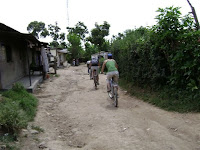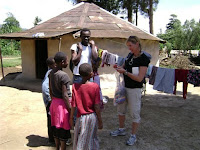To one side, they were building furniture by hand. No special machinery - just hand tools. Cabinets were in various states of finshing and chair bases were sitting ready for batting and fabric. Everything was just sitting on the dirt ground.
To the other side, we saw colourful fabrics hanging on clotheslines with African themed prints. This was a batik shop. Batik is a process using various coloured dyes and wax to create amazingly beautiful fabric hangings. I had the opportunity to try this in art class many years ago and recognized the artform.
Tino (furniture on left and batik shop to right):

This was our first stop on our day with Tino. We were going to be artists for a day and take home the finished piece as something special to remember from our trip. What a fabulous idea!
We had seen batik art along roadsides and at tourist shops, and now we know where and how it was done. Since the process can involve many steps, we would do a step or two, then head off to do something else, come back to complete another step, and so on until it was done. And so, there we were with pencils in hand, using some of their designs to create our own masterpieces
While we waited for it to dry in the sun, we went off to walk in the area. There are many children around as schools are closed during the month of December. It put a smile on our faces as they ran out from their small homes to greet the wazungu with their English greetings and our Swahili responses. Tino told us a bit about how they live and out of respect to their privacy, very few photos were taken during these walks. It will be something difficult to describe, but we'll remember the visuals.
Tino took us to his school. We met the pricipal - an amazing man who started the school in the 1990's, with a bit of prompting from friends and clients, as there were no guide schools in existence at the time. He has now developed a carriculum that has been approved by the Tanzanian gov't and based on the classroom we saw, is gaining in popularity. Tuition is approx 750 dollars per year, but he must now increase the tuition (which he knows will have an big impact on future students) due to the changes in the carriculum as no funding comes from elsewhere except for advanced specialty programs that appeal to special interest groups (ex, a California company helps fund advanced 'birding' programs).
As it turns out, Yusuf (our Kili guide) attended this same school and it seems he was a student they are very proud to call their own. Understandable!!
Next up - a roadside bike rental. It looked no different than a few guys who just happen to have their bikes sitting around, leaning against trees. But that is where we would rent our bikes. Tino had planned for us to ride to a local boma (Maasi village)called Warusha boma. We weren't sure whether they would allow us to view inside the huts, but we knew that we could meet the inhabitants and bring gifts to the children. So,we loaded up our backpacks with pens, markers, tennis balls, frisbees, balloons, compact mirrors for the women, some clothing, hats, and other things...all of which we had brought from home.
The ride was short, but all uphill. The roads were as difficult to ride as some single-track mountain bike routes back at home. I think funding for infrastructure such as roads, takes a lower priority in Arusha than we would expect from our tax dollars at home.


In any case, it was a real treat to be able to give the gifts to the inhabitants of the boma...lots of children who were incredibly appreciative. As we were leaving, we looked back to see the kids running around laughing and playing.






No comments:
Post a Comment